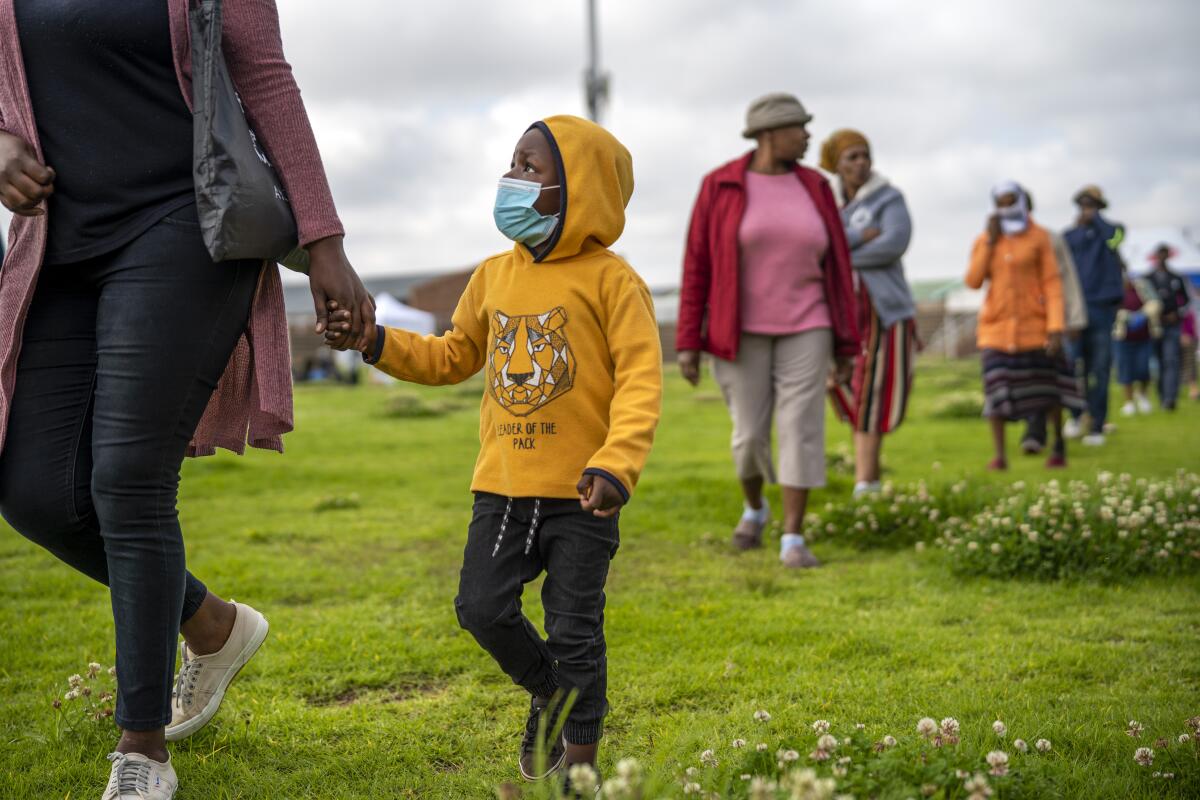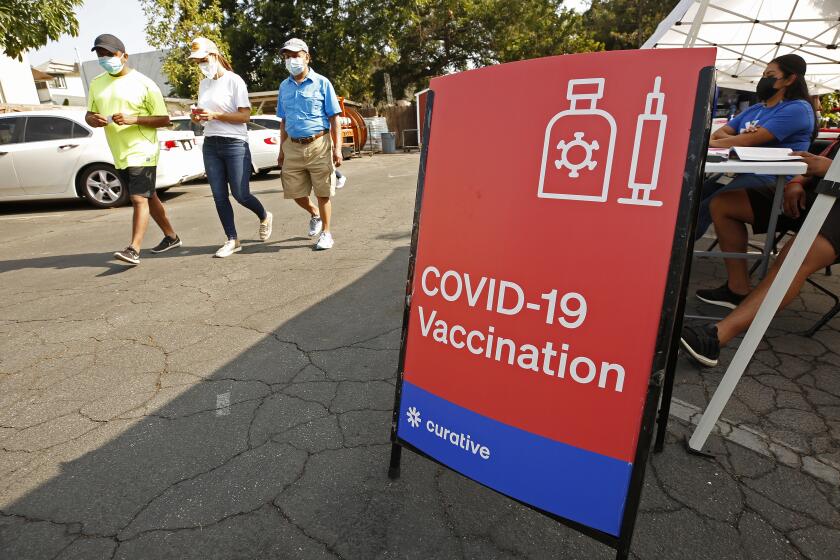What is the C.1.2 coronavirus variant — and should we be worried?

- Share via
Researchers are tracking a new coronavirus variant that was recently identified in South Africa and appears to have a startling number of mutations with the potential to give it an evolutionary advantage over other viral strains.
The C.1.2 variant was detected in May of this year and formally identified in July. It evolved from C.1, a version of the virus that dominated South Africa’s first wave of infections.
In May, C.1.2 accounted for 0.2% of 1,054 genomes sequenced by a team based in South Africa as part of a surveillance program, according to a preliminary report posted on MedRxiv. In June, that share was up to 1.6% of 2,177 samples, and by July, it had climbed to 2% of 1,326 samples.
That pattern is “similar to the increases seen in Beta and Delta in South Africa during early detection,” the study authors wrote, referring to coronavirus variants first identified in South Africa and India, respectively.
C.1.2 has made its way from Africa to Asia, Oceania and Europe. Scientists have spotted it in Botswana, Mauritius, China, New Zealand, Portugal, Switzerland and the United Kingdom.
Will the United States be next? Should we be worried?
To find out, we talked with Dr. Stuart Ray, an immunologist and infectious disease expert at Johns Hopkins University School of Medicine, and Ramon Lorenzo-Redondo, a molecular virologist at Northwestern University Feinberg School of Medicine.
What is the C.1.2 variant?
Maybe the first thing to know is what it is not. Currently, the World Health Organization categorizes troubling variants into two categories:
- Variants of interest: These have genetic markers linked to changes in transmissibility, receptor binding or other traits that may improve the virus’ fitness.
- Variants of concern: These are viruses for which there’s actual real-world evidence of traits that make them a bigger challenge to deal with. For instance, they may spread more easily, cause more severe disease or reduce the effectiveness of antibodies produced by the immune system.
By now, you’ve likely heard of Delta, the highly transmissible variant that’s causing cases to surge in many parts of the U.S. That’s one variant of concern, along with Alpha, Beta and Gamma.
By now, we all know that the Delta variant is about twice as transmissible as the original coronavirus. What exactly makes it so good at spreading?
The ones known as Eta, Iota, Kappa, Lambda and Mu are all categorized as variants of interest.
So far, C.1.2 has not made either list.
So why are people talking about it?
Scientists have been conducting genomic surveillance on samples from routine coronavirus tests conducted in public and private labs in South Africa — and in C.1.2 they’ve found a collection of worrisome mutations that, in other variants of concern and variants of interest, are thought to help the virus infect cells or evade the body’s defenses.
And that’s not all: There are also “some extra mutations that could have importance” to how successful the virus ends up being, Lorenzo-Redondo said.
Ray agreed.
“It has some mutations that could be called ‘mutations of interest’ because they are the kinds of mutations that make a variant become a variant of interest,” he said.
Many of the shared mutations, such as one called N501Y, are linked to an improved ability to bind with the ACE2 receptor on the outside of a cell; the virus targets this receptor in order to “unlock” cells and gain entry.
Other mutations are linked to reduced effectiveness of antibodies, whether they’re generated in response to a COVID-19 vaccine or a prior coronavirus infection.
Why are people saying it’s “highly mutated”?
The variant seems to have racked up a large number of mutations in a short period of time. The authors of the MedRXiv report suggest that C.1.2’s rate of evolution is about 1.7 times as fast as the current global rate for the coronavirus in general.
“It is striking because it carries so many changes that are worrisome, and it’s also got this characteristic that it appears to have evolved rapidly,” Ray said.
The report authors said this higher rate of evolution seemed to parallel the early rise of other influential variants, including Alpha, Beta and Gamma.
Ray was quick to draw a distinction between rate of mutations and rate of evolution. Mutations are necessary for evolution to take place, but they do not guarantee it.
“Mutation is a random process,” he said. It can take place anytime a virus replicates in an infected host’s body — and viruses replicate a lot.
Most mutations don’t actually benefit the virus. A few may confer some kind of an advantage by helping a virus adapt when facing particular environmental pressures or presented with new opportunities to spread.
“When an organism gains a new niche … it has new challenges to face,” Ray said. When that happens “it might evolve more rapidly for a little while,” he said.
COVID-19 patients who take months to overcome their coronavirus infections despite treatment can become incubators of dangerous new strains.
For their part, the report authors say that C.1.2’s high number of mutations might be the result of “a period of accelerated evolution in a single individual with prolonged viral infection” that lasted far longer than the more typical two-week run.
With the ability to replicate freely for a long period of time in one person’s body, those rare beneficial mutations can really start to add up.
Are vaccines, or the antibodies from a previous infection, less effective against C.1.2?
A number of C.1.2’s mutations affect the virus’ spike protein, which is what it uses to “unlock” target cells. It’s also the protein that mRNA vaccines teach the body’s immune system to recognize so they’ll be prepared for an attack.
If antibodies are created in response to an infection, they are tailored to the particular spike protein used by the invading virus.
Either way, changes to the spike protein “are worrisome because they can have an impact on antibodies and other immune responses that can interfere with the virus getting into cells,” Ray said.
If those changes are significant enough to prevent antibodies from recognizing C.1.2, it may be easier for it to slip past the immune system.
“We have to be wary,” Ray said.
But antibodies aren’t the be-all and end-all of the body’s immune response, he said. T cells and other so-called lymphocytes can attack foreign bodies, including a virus it encounters.
“There’s still a lot that the T cells can recognize, Ray said.
How worried should we be?
You can take a breath. Experts say the emergence of a new variant doesn’t necessarily spell imminent doom.
“A lot of the variants we hear about, they’re sort of flash in the pan — we’re not quite sure whether they’re going to grow into something big,” Ray said.
Right now, Delta is the much bigger concern — and, as the dominant strain here in the U.S., the variant to beat.
“We’ve learned that these footraces between variants really tell us a lot about how aggressive they are,” Ray said, pointing to the way Delta quickly grew to account for most new coronavirus infections. “If a variant can’t outcompete” its rivals, it’s less likely to be an equally persistent threat.
“We would need to see this C.1.2 outcompete Delta somewhere. And, of course, one possibility is that it will gain some function that will allow it to do that,” Ray said. “So we have to be vigilant.”
Unleashing a fast-spreading coronavirus variant on a half-vaccinated population can lead to a vaccine-resistant strain.
The bigger worry is this, Lorenzo-Redondo said: That more dangerous variants will crop up as infections continue to spread through vulnerable, unvaccinated populations.
“This is a global war right now,” he said.
To avoid the rise of more variants that could prolong the epidemic, he said, more people around the world need to have access to vaccines.










